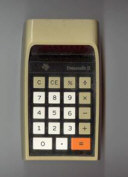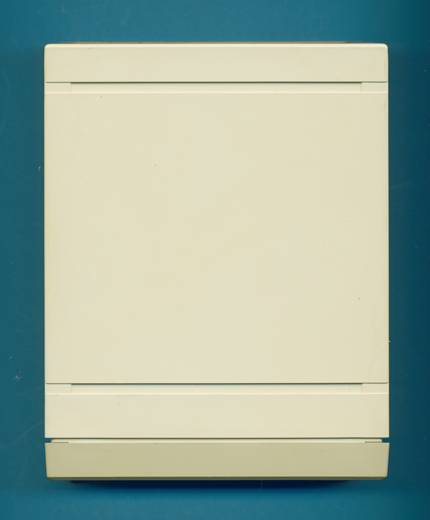
DATAMATH CALCULATOR MUSEUM
 |
DATAMATH CALCULATOR MUSEUM |
Texas Instruments HX-3100 Data Modem
| Date of introduction: | 1983 | Display technology: | |
| New price: | $99.95 (MSRP 1983) | Display size: | |
| Size: | 5.8" x 4.6" x 1.4" 148 x 118 x 36 mm3 |
||
| Weight: | 9.6 ounces, 272 grams | Serial No: | 00 1071 |
| Batteries: | 4*AA Alkaline | Date of manufacture: | wk 08 year 1984 |
| AC-Adapter: | AC9203 | Origin of manufacture: | USA (LTA) |
| Precision: | Integrated circuits: | CPU: TMC70C20 C71003 ASIC: LSI Logic L1A0037 MODEM: TMS99532A |
|
| Memories: | HEX-BUS Device ID: | 70 | |
| Program steps: | Courtesy of: | Joerg Woerner | |
| Download manual: | |

![]()
 Texas Instruments designed in 1982 with the HEX-BUS a very innovative interface to connect
intelligent peripherals like printers, modems or even a video interface to its new Compact Computer System
CC-40 and planned to use it with the
never released TI-99/8 home computer.
Texas Instruments designed in 1982 with the HEX-BUS a very innovative interface to connect
intelligent peripherals like printers, modems or even a video interface to its new Compact Computer System
CC-40 and planned to use it with the
never released TI-99/8 home computer.
 The physical interface of the HEX-BUS is a rather simple 8-pin
connector and with peripherals having always two HEX_BUS ports, multiple
peripherals can be connected in a daisy-chain mode. The Hardware of the HEX-BUS uses four Data-Signals [D0, D1, D2, D3], two Handshake-Signals
[HSK], [BAV] and a common ground signal [GND]. The remaining line was reserved
for future use and labeled [FUT]. With the drivers being "open collector", the
interface allows bi-directional data communication, each Byte is transmitted in
two 4-bit words in a Master/Slave protocol. Texas Instruments published not only
the specifications of the HEX-BUS and the software requirements for peripherals,
but even offered two different Intelligent Peripheral Bus Controllers (IBC),
realized as ASICs (Application Specification Integrated Circuits):
The physical interface of the HEX-BUS is a rather simple 8-pin
connector and with peripherals having always two HEX_BUS ports, multiple
peripherals can be connected in a daisy-chain mode. The Hardware of the HEX-BUS uses four Data-Signals [D0, D1, D2, D3], two Handshake-Signals
[HSK], [BAV] and a common ground signal [GND]. The remaining line was reserved
for future use and labeled [FUT]. With the drivers being "open collector", the
interface allows bi-directional data communication, each Byte is transmitted in
two 4-bit words in a Master/Slave protocol. Texas Instruments published not only
the specifications of the HEX-BUS and the software requirements for peripherals,
but even offered two different Intelligent Peripheral Bus Controllers (IBC),
realized as ASICs (Application Specification Integrated Circuits):
|
• TI # 1052911, LSI Logic ASIC L1A0037, 22 pin Package • TP0370, new version, 28 pin package |
Texas Instruments dropped out of the home computer market in March 1984 - after selling more than 2.5 million of the famous TI-99/4A - and production of the CC-40 was ceased immediately after. Consequently was the development of the HEX-BUS terminated and only a few of the already announced HEX-BUS peripherals were manufactured in significant quantities. Interesting fact to know: The TI-74 BASICALC and TI-95 PROCALC computers introduced in 1985 as successor of the CC-40 use a 10-pin Dock-Bus which is compatible to the HEX-BUS and added three signals: [RESET] and System Power Distribution In [PI] and Out [PO] to power peripherals from the computer or the computer from peripherals.
Texas Instruments announced or released during the short live of the Compact Computer 40 eight different products like printers, plotters and even a serial interface using the HEX-BUS Interface. Additional peripheral devices were planned or released from Third Party vendors but are not listed as of now in our overview:
Part |
Name / Description |
MSRP (1983) |
Status |
| HX-1000 | Printer / Plotter 4 colors | $199.95 | Series |
| HX-1010 | Printer 80 (Thermal ribbon) | $249.95 | Series |
| HX-1100 | Video Interface | $99.95 | Prototype |
| HX-2000 | Wafertape Digital Tape Drive | $139.95 | Prototype |
| HX-3000 | RS-232 Interface | $99.95 | Series |
| HX-3000/P | RS-232 + Parallel Interface | $124.95 | Series |
| HX-3100 | Data Modem | $99.95 | Series |
| HX-5102 | Disk Drive/Controller | t.b.d. | Prototype |
The HX-3100 direct-connect 300-baud telephone modem enables Texas Instruments Compact Computers to communicate with other computers using telephone lines. The unit is Bell 103 compatible, allowing access to subscription data-base services across the country. The modem connects directly to telephones with modular (RJ11) plugs.


 Dismantling
this battery operated HX-3100 manufactured in February 1984 by Texas Instruments in their
Lubbock, Texas facility, reveals a design with two printed circuit boards (PCBs)
connected with a flexible jumper cable.
Dismantling
this battery operated HX-3100 manufactured in February 1984 by Texas Instruments in their
Lubbock, Texas facility, reveals a design with two printed circuit boards (PCBs)
connected with a flexible jumper cable.

 One PCB of the HX-3100 holds all
the connectors to the outside world and the power supply, while the second PCB
illustrates a single-chip microcontroller design with three main building blocks:
One PCB of the HX-3100 holds all
the connectors to the outside world and the power supply, while the second PCB
illustrates a single-chip microcontroller design with three main building blocks:
CPU
(Central processing Unit): The Texas Instruments TMC70C20 microcontroller is a
member of the
TMS7000 family
manufactured in CMOS technology. The original design of the TMS7000 series was
introduced in 1981 as an 8-bit extension of the
TMS1000 Family to compete with
already well established Intel i8051, Motorola M6801, and Zilog Z8 products. The first chips sported 128
bytes of on-chip RAM (Random Access Memory) and either 2k Bytes or 4k Bytes of ROM (Read Only Memory).
The featured HX-3100 sports a
TMC70C20 with ROM-Code C71003, equipped with 2k Bytes of ROM. Read more about
TI Standard
Symbolization used in the Eighties with ICs manufactured in a metal–oxide–semiconductor (MOS) process.
IBC (Intelligent Peripheral Bus Controllers): The IBC ASIC (Application Specific Integrated Circuit) with TI part number 1059211 was manufactured by LSI Logic in their then state-of-the-art 2 um CMOS process and is marked accordingly with L1A0037 (L1A references to the ASIC family and 0037 is # of the design within the ASIC family).
FSK MODEM (Frequency-Shift-Keyed Modem): The TMS99532A FSK Modem was introduced in 1982 by Texas Instruments and is a telecommunication device that transmits and receives binary serial data over the U.S. public switched telephone network using frequency-shift-keyed modulation. The TMS99532A is compatible with Bell 103 Series compatible data sets and will communicate at up to 300 bits per second (Baud).
![]()
If you have additions to the above article please email: joerg@datamath.org.
© Joerg Woerner, October 25, 2019. No reprints without written permission.